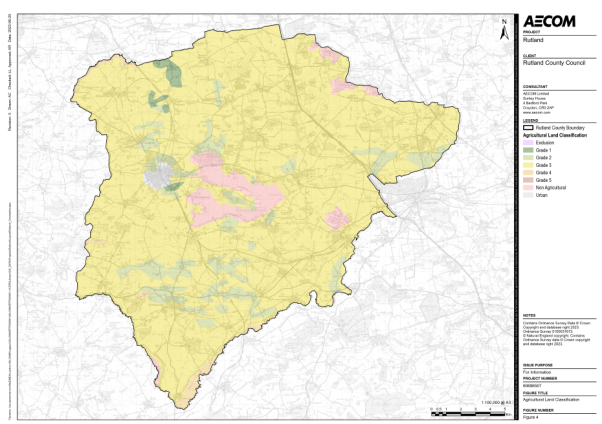Regulation 19 Rutland Local Plan
Best and Most Versatile Agricultural Land
What will this policy do?
Agriculture is the predominant land use in Rutland, comprising over 75% of Rutland with specialist arable and pastoral farms, the primary function of which is food production. To sustain long-term food security and healthy soils in a changing climate, the protection of the best and most versatile (BMV) land is key to ensure that food production is not negatively impacted by development. Figure 7 shows the agricultural classification (ALC) within Rutland. Agricultural land classification maps are available on Natural England's web site Agricultural Land Classification Map East Midlands Region - ALC005 (naturalengland.org.uk) and on the Magic Map Application (defra.gov.uk)
Figure 7 – Agricultural Land Classification

Policy EN6 - Protecting agricultural land View responses
Planning permission for development which would lead to the loss of Grade 1, 2 and 3a agricultural land will only be permitted where:
- the land is allocated for development in the Local Plan; or
- it has been clearly demonstrated that for significant development of agricultural land resulting in the loss of Best and Most Versatile land that there are no other more suitable and sustainably located sites available and that the needs for development are sufficient to override the need to protect Best and Most Versatile agricultural land; or
- Grade 3 land may be permitted for Solar PV where the proposal meets the requirements of Policy CC8 - Renewable energy, however grade 1 and 2 will be ruled out for renewable energy use.
Why is this policy needed?
The NPPF requires Local plans to consider the economic and other benefits of the best and most versatile agricultural land (BMV). Where significant development of agricultural land is considered, the Council should seek to use areas of poorer quality land in preference to higher quality, subject to other sustainability considerations. 'A Green Future: Our 25-year plan to improve the Environment' sets out the government's 25-year plan to improve the health of the environment by using natural resources more sustainably and efficiently. It plans to protect the best agricultural land and put value on soils as part of our natural capital. They have set a target to manage soils in a sustainable way by 2030.
BMV Agricultural land is graded from 1 to 3a. The highest grade of land is that which:
- gives a high yield or output
- has the widest range and versatility of use
- produces the most consistent yield
- requires less input
Development of the best and most versatile agricultural land will only be supported where it can be demonstrated that the need for the development, its benefits and/or sustainability considerations outweigh the need to protect such land taking into account the economic and other benefits of the best and most versatile agricultural land. For development on BMV land, the Construction Method Statement submitted with the planning application should include a soil survey and soil management plan. These should demonstrate evidence of good practice for soil management during and after construction.
A recent Written Ministerial Statement (published on 15th May 2024) provides the government's up to date policy on balancing the need for renewable energy production and the importance of BMV land for food security. It reiterates footnote 62 in the NPPF and states that: …due weight needs to be given to the proposed use of Best and Most Versatile land when considering whether planning consent should be granted for solar developments. For all applicants the highest quality agricultural land is least appropriate for solar development and as the land grade increases, there is a greater onus on developers to show that the use of higher quality land is necessary.'
The need to identify and maintain an appropriate supply of land for development creates some pressure for development of agricultural land despite a focus on bringing forward brownfield sites where possible.
Only a small part of the County is graded as Best and Most Versatile, however some of that land is located around the County town of Oakham and some Larger Villages, this makes identifying land for development challenging in this location and it may be that some BMV land is necessary to ensure that the need for homes and jobs can be met in a sustainable manner.
Supporting Evidence
Rutland Renewable Energy Study 2023
Green and Blue Infrastructure Strategy 2023
